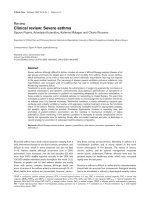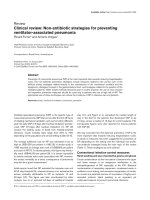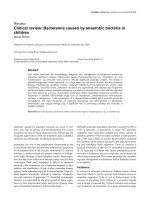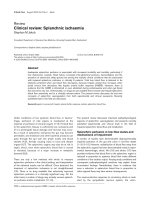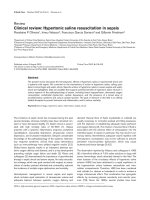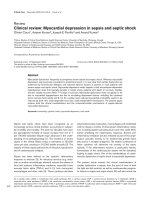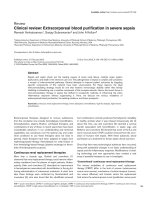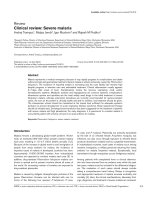Báo cáo y học: "Clinical review: A review and analysis of heart rate variability and the diagnosis and prognosis of infection" pps
Bạn đang xem bản rút gọn của tài liệu. Xem và tải ngay bản đầy đủ của tài liệu tại đây (71.11 KB, 7 trang )
Available online />Page 1 of 7
(page number not for citation purposes)
Abstract
Bacterial infection leading to organ failure is the most common
cause of death in critically ill patients. Early diagnosis and
expeditious treatment is a cornerstone of therapy. Evaluating the
systemic host response to infection as a complex system provides
novel insights: however, bedside application with clinical value
remains wanting. Providing an integrative measure of an altered
host response, the patterns and character of heart rate fluctuations
measured over intervals-in-time may be analysed with a panel of
mathematical techniques that quantify overall fluctuation, spectral
composition, scale-free variation, and degree of irregularity or
complexity. Using these techniques, heart rate variability (HRV) has
been documented to be both altered in the presence of systemic
infection, and correlated with its severity. In this review and
analysis, we evaluate the use of HRV monitoring to provide early
diagnosis of infection, document the prognostic implications of
altered HRV in infection, identify current limitations, highlight future
research challenges, and propose improvement strategies. Given
existing evidence and potential for further technological advances,
we believe that longitudinal, individualized, and comprehensive
HRV monitoring in critically ill patients at risk for or with existing
infection offers a means to harness the clinical potential of this
bedside application of complex systems science.
Introduction
Bacterial infection remains a major cause of suffering and
death, particularly in patients with impaired host defence.
Severe sepsis and septic shock are the most common
causes of mortality in critically ill patients and account for
10% of ICU admissions [1]. Despite over 20 years of intense
basic science and epidemiologic research, mortality has
remained at approximately 50% [2] with the average annual
cost in the USA for treating severe sepsis amounting to
$16.7 billion nationally [3]. In spite of immense and detailed
knowledge regarding mechanisms, pathways, mediators,
transcription factors, receptor levels, and gene activation
involved in the host response to severe sepsis leading to
organ dysfunction, the understanding of the whole system
working in concert is limited.
Clinically, we diagnose infection based on an increased
absolute value of one or more vital signs along with other
clinical evidence of both a pathogen and host response. A
diagnosis and intervention is ‘triggered’ whenever vital signs
exceed specific thresholds [4]. Although it is the best system
currently available, waiting for a fever to spike or the
development of tachycardia to signify alteration to the host
response represents a crude and potentially late means to
diagnose infection. Clinicians are well aware that late diag-
nosis, unexpected and rapid deterioration, ICU admission,
and organ dysfunction represent common case histories of
critically ill patients. Early diagnosis, rapid and adequate
resuscitation, restoration of oxygen delivery, timely institution
of appropriate antibiotics, and source control can undeniably
save lives in patients with severe infection. In fact a study by
Kumar and colleagues [5] demonstrated that each hour of
delay in the initiation of the duration of effective antimicrobial
therapy was associated with a mean decrease in survival of
7.6%.
The concept of early goal-directed therapy (EGT) was
popularized by Rivers and colleagues [6] with outpatients
who presented symptoms of a systemic infection. In a large
single-centre randomized trial, it was demonstrated that
Review
Clinical review: A review and analysis of heart rate variability and
the diagnosis and prognosis of infection
Saif Ahmad
1
, Anjali Tejuja
1
, Kimberley D Newman
1
, Ryan Zarychanski
2,3
and Andrew JE Seely
1,4,5
1
Ottawa Hospital Research Institute, Ottawa, Ontario, K1Y 4E9, Canada
2
Section of Critical Care, Department of Internal Medicine, University of Manitoba, Winnipeg, Manitoba, R3A 1R9, Canada
3
Department of Haematology and Medical Oncology, CancerCare Manitoba, Winnipeg, Manitoba, R3E 0V9, Canada
4
Division of Thoracic Surgery, University of Ottawa, Ottawa, Ontario, K1H 8L6, Canada
5
Department of Critical Care Medicine, University of Ottawa, Ottawa, Ontario, K1H 8L6, Canada
Corresponding author: Andrew JE Seely,
Published: 24 November 2009 Critical Care 2009, 13:232 (doi:10.1186/cc8132)
This article is online at />© 2009 BioMed Central Ltd
APACHE = Acute Physiological and Chronic Health Evaluation; ApEn = approximate entropy; EGT = early goal-directed therapy; FFT = fast Fourier
transform; HF = high frequency; HR = heart rate; HRC = heart rate characteristics; HRV = heart rate variability; LF = low frequency; MODS = mul-
tiple organ dysfunction syndrome; MSE = multiscale entropy; RMSSD = root mean square successive difference; SAA = sample asymmetry analy-
sis; SampEn = sample entropy; SD = standard deviation.
Critical Care Vol 13 No 6 Ahmad et al.
Page 2 of 7
(page number not for citation purposes)
patients who were assigned to EGT, which involved maintain-
ing adequate systemic oxygen delivery and tissue perfusion,
presented with reduced subsequent organ dysfunction and
improved hospital survival compared to those receiving
standard therapy. In a recent publication, examining EGT in
severe sepsis, Rivers and colleagues [7] concluded that the
EGT protocol resulted in improved patient outcome and cost-
effectiveness in treating sepsis. However, they noted that
EGT still requires further development and optimization. For
example, the EGT protocol comprises several interventions,
including the administration of fluids, vasoactive agents, and
red blood cells. Therefore, it is unclear what aspect(s) of the
protocol were actually responsible for the reduction in death
for the EGT group.
Serologic tests and biomarkers, such as C-reactive protein,
endotoxin, brain natriuretic peptide, procalcitonin, and
endogenous protein C, may also aid in the early diagnosis of
severe infection in the future [8-21]. At present, however,
their use is limited because of lack of diagnostic capability
and long timelines in the return of results.
Given the emergence of early resuscitation as a key factor in
improving outcome in sepsis, there is need to develop more
rapid, sensitive, and specific diagnostic strategies that could
complement or surpass the existing ones.
The host response to infection involves a dynamic web of
interactions between organs, cells, mediators, molecules, and
genes - thus, giving rise to a complex non-linear system [22].
Complex systems are loosely defined as systems with
properties that cannot be wholly understood by understand-
ing the parts of the system [23]. Complex systems science is
distinct from and complementary to analytical science and
epidemiology and offers an innovatory means to address the
problem of diagnosis, prognosis, and prediction of disease.
Specifically, complex systems science uses a novel analysis
of rhythms or fluctuations over time that encompasses
concepts such as nonlinear dynamics, fractals, and ‘chaos
theory’. Notably, this approach of integrating information over
time in individual patients contrasts with traditional methods,
which use population-based statistical models to study the
absolute value of clinical variables [24]. This complex
systems approach of analyzing intervals-in-time or patterns of
variation over time has been termed ‘variability analysis’.
Variability analysis is essentially a collection of various
mathematical and computational techniques that characterize
biologic time series with respect to their overall fluctuation,
spectral composition, scale-free variation, and degree of
irregularity or complexity. A growing exploration of patterns of
variation or fluctuations in physiologic time series, particularly
heart rate variability (HRV) analysis, has been shown to
provide clinically useful and otherwise ‘hidden’ information
about the health of the system producing the dynamics. For
example, Fourier spectral analysis of heart rate (HR) data has
shown that frequency profiles characterizing HRV are altered
during illness and that the degree of alteration of these
frequency profiles correlates with illness severity in conditions
ranging from hypovolaemia [25] to heart failure [26-28], from
hypertension [29-30] to coronary artery disease [31-32] and
from angina [33] to myocardial infarction [34]. These studies
demonstrate that HRV is consistently and reproducibly
altered in illness, and the degree of HRV alteration is prog-
nostic of illness severity.
There are numerous analysis techniques used to evaluate
altered variability or altered patterns of change over time. The
most straightforward technique for measuring HRV involves
the computation of the standard deviation (SD) of the time-
series of time intervals between consecutive heart beats (R-R
intervals). Other measures such as the SD of 5 minute
averages with specific thresholds (for example, SD <70 ms)
and more have been extensively studied [35,36]. These time
domain measures of SD are complemented by frequency
domain analyses, which evaluate the frequency spectrum of a
HR signal. According to Fourier theory, any time series may
be considered as a sum of sinusoidal oscillations with distinct
frequencies. Conversion from a time domain to a frequency
domain analysis is made possible with the fast Fourier
transform (FFT) or the discrete Fourier transform, which can
quantify the spectral content of the signal in defined ranges
of frequencies [37]. Techniques like wavelet analysis are
referred to as ‘time-frequency domain analyses’. The wavelet
analysis technique not only determines the frequency compo-
nents of the input signal but also their locations in time
[38,39]. In order to quantify the degree of information,
disorder, or complexity of a time-series, entropy analyses
produce single (for example, approximate entropy (ApEn) and
sample entropy (SampEn)) or multiple values (for example,
multiscale entropy (MSE)) that reflect degree of irregularity
[40-42]. Providing yet another distinct evaluation, scale-
invariant analyses provide a measure of patterns of variation
that are present across a range of time scales. Given that the
frequency of occurrence of variations is inversely proportional
to their magnitude and that magnification of the time-series
reveals similar patterns, it is possible to quantify scale-
invariant variation (utilizing detrended fluctuation analysis or
power law analysis) to facilitate comparison between time
periods [43].
Taking inspiration from previous studies that used these
techniques to quantify HRV and that have consistently shown
an inherent link between HRV and illness, the study of HRV
and its association with infection has emerged as an
important stream of research for the diagnosis and manage-
ment of sepsis and septic shock. In this review article, we
analyze the use of HRV analysis as a means of establishing
diagnosis of infection and its capacity to prognosticate
severity of infection. In addition, we evaluate the limitations of
this technology in its current state, identify future challenges,
and propose strategies that may render it a useful clinical
bedside application for the management and treatment of
sepsis.
Early diagnosis of infection with heart rate
variability analysis
Several studies have examined the usefulness of HRV
analysis for early diagnosis of infection, particularly in neo-
nates and infants. The majority of work in this area was done
by Griffin, Moorman, and colleagues, who developed a novel
and proprietary measure, heart rate characteristics (HRC), to
assess HRV in infants at risk of developing sepsis. In their
studies, it was reported that abnormal HRC with reduced
variability and transient decelerations preceded neonatal/
infant sepsis [44-49]. A predictive model, based on multi-
variable logistic regression, was developed for the early
detection of sepsis in infants. In one of the clinical trials, data
were collected from 678 infants who spent more than 7 days
in the University of Virginia Neonatal ICU from July 1999 to
July 2003 [44]. HRC were measured for 137 subjects whose
blood cultures were positive and confirmed sepsis. The HRC
were found to be significantly correlated with sepsis and the
receiver-operating characteristic analysis yielded an accuracy
of 73%. A major finding of the research by Griffin and
colleagues is that HRC computation, which involves a con-
tinuous monitoring and analysis paradigm, independently
complements information available through conventional
point-in-time laboratory tests and vital sign assessment. Their
studies reported abnormalities in HRC that were noticeable
12 to 24 hours prior to the clinical diagnosis of sepsis based
on traditional clinical markers (for example, fever, tachycardia
or positive cultures). Although Griffin and colleagues do not
provide a numerical value of the specificity achieved by the
HRC for early diagnosis of neonatal sepsis, they do mention
that ‘not all abnormal readings inevitably indicate imminent
sepsis or other untoward events’. This observation seems to
point towards a diminished specificity of the HRC for early
diagnosis of neonatal sepsis.
In another study, Cao, Griffin, Moorman and colleagues [50]
employed a measurement of the degree of nonstationarity in
the heart rate signal to predict neonatal sepsis. Nonstation-
arity is defined as the tendency of the statistical properties of
a time series (for example, mean, SD) to vary during intervals
throughout the time series. They measured the degree of
nonstationarity using the Kolmogorov-Smirnov test whereby
actual HR data were compared and correlated with a purely
stationary (artificially generated) dataset. Although the
authors reported abnormal HRC of reduced variability and
transient decelerations 12 to 24 hours prior to neonatal
sepsis, in addition to a positive correlation between HRC and
clinical data as per their earlier work [45], little additional
clinical benefit was highlighted vis-à-vis the new stationarity
statistic discussed in this paper [50]. The main conclusion
was that neonatal heart rate data are predominantly non-
stationary and that they become more nonstationary in the
early course of sepsis.
The elements of HRC consist of various statistics and
measures for analyzing HRV. One such measure developed
by Kovatchev, Griffin and colleagues [51] for the early
diagnosis of sepsis and systemic inflammatory response
syndrome in neonates is the sample asymmetry analysis
(SAA). SAA provides a measure of changes in the shape of
frequency histograms of R-R intervals, resulting from reduced
variability and transient decelerations. In this study conducted
on 158 infants admitted to the ICU at the University of
Virginia Hospital, the SAA statistic of R-R intervals increased
significantly from its baseline value of 3.3, 3 to 4 days prior to
the onset of sepsis and systemic inflammatory response
syndrome. The authors conclude that these results are
clinically useful for predicting early onset of sepsis. However,
they also point out the limitations of the technique. The major
limitation is that even though sample asymmetry is signifi-
cantly elevated before sepsis, it shows considerable variation
amongst subjects, making it difficult to define a threshold for
the onset of sepsis that is valid for all infants. That is, an
elevated SAA value in one infant may signify sepsis, although
the same elevated value may also be observed in another
normal infant - thus, compromising the specificity of the
absolute value of the SAA metric.
In addition to HRC, Griffin, Moorman, and colleagues pro-
posed the SampEn analysis [52] of HR time series, a variant
of the ApEn analysis [40], to study sepsis in neonates. They
studied 89 infants admitted to a tertiary care neonatal ICU.
Numerical simulations, based on the SampEn statistic, were
performed on 21 subjects who suffered from episodes of
sepsis. The major finding was that entropy falls or HR
becomes more regular as early as 24 hours before clinical
signs of sepsis appear. The main drawback associated with
the SampEn metric for early diagnosis of neonatal sepsis is
that of false positives. Griffin and colleagues observe that
SampEn falls due to increased regularity of neonatal HR time
series, which is indeed associated with sepsis. However, they
note that such a decrease in SampEn may also be observed
when there are spikes or noise in neonatal HR time series,
which does not signify increased regularity or sepsis. There-
fore, compromised data quality directly impacts the specificity
of the SampEn metric.
The studies reviewed in this section highlight the potential
clinical benefits of studying HRV for the early diagnosis of
infection. Most of the studies report HRV analyses to
diagnose sepsis 12 to 24 hours prior to traditional clinical
methods. In fact, one study reported observable changes in
HRC as early as 3 to 4 days before the onset of sepsis [51].
These studies report a satisfactory sensitivity associated with
HRV analysis for the early diagnosis of sepsis, although the
specificity is somewhat compromised. Moreover, it remains
unclear exactly what one is measuring that far (especially 3 to
4 days) in advance of clinical diagnosis of infection. Does
altered HRV provide an early warning of increased risk of
infection versus early detection of the presence of infection?
Available online />Page 3 of 7
(page number not for citation purposes)
It is noteworthy that the studies reported in the literature for
early diagnosis of sepsis utilizing HRV analysis have so far
only been performed on neonates. No study has reported the
evaluation of the HRV analysis technology for early diagnosis
of infection in adults. In addition, a panel of HRV analysis
techniques (for example, time, frequency, time-frequency,
complexity, and fractal domain analysis techniques) is
available to clinicians and investigators. However, no study
has employed this panel of techniques for either examining
their usefulness or for comparing one against the other for
early diagnosis of infection in infants or adults.
In a recent pilot investigation, we (Ahmad and colleagues
[53]) studied the usefulness of a panel of HRV analysis tech-
niques for the early diagnosis of sepsis in adult bone marrow
transplant patients. We monitored multi-parameter HRV
continuously for an average of 12 days in 17 bone marrow
transplant patients. Fourteen patients developed sepsis (that
is, clinical diagnosis of infection along with systemic inflam-
matory host response) requiring antibiotic therapy, whereas
three did not. On average, for 12 out of 14 infected patients,
a significant (25%) reduction prior to the clinical diagnosis
and treatment of sepsis was observed in SD, root mean
square successive difference (RMSSD), SampEn and MSE,
FFT, detrended fluctuation analysis, and wavelet HRV
metrics. For infected patients (n = 14), wavelet HRV demon-
strated a 25% drop from baseline 35 hours prior to sepsis on
average. For three out of three non-infected patients, all
measures, except RMSSD, SampEn, and MSE showed no
significant reduction. Thus, our study demonstrated satisfac-
tory sensitivity and specificity of multiple HRV analysis
metrics for the early diagnosis of sepsis in adults. However,
these preliminary results require further validation with a
larger sample size.
Based on studies reviewed in this section, including our own
pilot study, we believe that further investigation, both obser-
vational as well as experimental, is warranted to realize the full
potential of HRV analysis for the early diagnosis of infection.
Prognostication of infection with heart rate
variability analysis
Determining prognosis, namely mortality risk that is secondary
to the severity of the host response to infection, is another
important avenue of research pertaining to HRV analysis and
infection. The prognostic capacity of HRV analysis in sepsis
has been evaluated by correlating standardized measures of
illness severity with severity of alteration in HRV, and by
demonstrating poor outcome or high mortality in subgroups
of patients who demonstrate significantly altered HRV. In this
manner, several studies have shown that HRV analysis may
provide successful prognostication of infection in the critically ill.
The frequency domain Fourier spectral analysis [37] has
often been used as a prognostic tool for the prediction of
patient outcome in the ICU [54]. In one study, involving 52
patients from an adult ICU, a progressive decrease (down-
trend) in the power densities of the Fourier low frequency
(LF) and very low frequency spectra was found to be a
significant marker of deterioration and mortality [55]. The
predicted outcome was based on trend changes in the LF
and very low frequency components and correlated positively
with Acute Physiological and Chronic Health Evaluation
(APACHE) II scores. The authors report a compromised
sensitivity and specificity of the Fourier spectral analysis in
predicting outcome whenever the input HR signal became
nonstationary, that is, increased or decreased abruptly. These
abrupt changes caused surges in the FFT LF components,
which reduced the overall accuracy of predicting subsequent
deterioration and mortality. In another ICU study, Fourier
spectral analysis of HR in combination with haemodynamic,
echocardiographic, and serum cardiac markers was used for
prognostication of patients suffering from sepsis [56]. In this
investigation, consisting of 25 patients with septic shock, the
mortality rate was 60%. HRV was measured by means of
Fourier high frequency (HF) and LF components of the R-R
interval time series. A positive correlation was found between
LF power and mortality. The authors conclude that HRV
measures based on Fourier spectral analysis have the
potential for prognostication of infection in critically ill
patients. In a similar study, Piepoli and colleagues [57]
analyzed 40-minute continuous electrocardiogram signals in
the intensive therapy unit using Fourier spectral analysis in 12
patients during septic shock and during recovery from septic
shock. Ten patients recovered, whereas two died. For the 10
patients who recovered, the normalized FFT LF component
(LFnu) increased from 17 ± 6 during septic shock to 47 ± 9
(P < 0.02) by the time of discharge (post-shock). The two
patients who died did not show an improvement in the LFnu
component.
There is a high risk of multiple organ dysfunction syndrome
(MODS) in patients with sepsis in the ICU. Fourier spectral
analysis was used by Pontet and colleagues [58] as an early
marker of MODS in septic patients. Their study followed 46
septic patients who had no signs of MODS at the time of
admission to the ICU. Eleven of the 46 patients subsequently
developed MODS, 28 did not, and 7 were excluded. Thus,
the patients were divided into MODS (n = 11) and non-
MODS (n = 28) groups. Despite similar APACHE II scores
for the two groups, most of the eight HRV indices (computed
during the first 24 hours of admission) were found to be
significantly reduced in the MODS group of patients. Fourier
LF power correlated positively with subsequent MODS while
HF power was significantly reduced for patients who subse-
quently developed MODS. The FFT LF component achieved
the highest accuracy (receiver-operating characteristic area
under the curve = 0.87, sensitivity = 91%, specificity = 79%)
in predicting MODS. The mortality rate was 60% in the
MODS group whereas it was 0% in the non-MODS group.
These results and others [54,59] demonstrate that HRV
analysis is not only of potential clinical use but may actually
Critical Care Vol 13 No 6 Ahmad et al.
Page 4 of 7
(page number not for citation purposes)
surpass established clinical techniques (for example,
APACHE II scores) for identifying the risk of MODS in
patients suffering from sepsis.
HRV analysis was also evaluated as a clinical tool to predict
the outcome of sepsis in the emergency department. A study
performed in the emergency department by Barnaby and
colleagues [60] validated earlier work performed in the ICU
[57,61], whereby a normalized LF component (LFnu) was
correlated with the APACHE II score and the Sequential
Organ Failure Assessment (SOFA) score and an inverse
relationship between LFnu and the two measures of illness
severity was demonstrated. Moreover, in this study, Barnaby
and colleagues determined the threshold values for both
LFnu and the ratio of LF to HF (LF/HF) components. All
patients who had an LFnu value <0.5 or an LF/HF ratio <1.0
required more interventions (for example, ventilatory support,
ICU admission, and so on) or died. Those patients who had
an LFnu value >0.5 or an LF/HF ratio >1.0 did not require
such support and did not die. Again, Barnaby and colleagues’
results for HRV thresholds in the emergency department
conformed to an earlier investigation performed in the ICU
where it was demonstrated that sepsis was the main
condition leading to a decrease in the LF/HF ratio (LF/HF <1)
and that a reduced LF/HF ratio correlated with an increased
risk of death [62]. Chen and Kuo [63] performed another
similar study, evaluating which emergency department
patients with sepsis will progress to septic shock. They
characterized HRV using not only the frequency domain
Fourier spectral analysis but also the time domain RMSSD
metric. They found that at baseline (first 10 minutes of ECG
recording), the RMSSD metric, HF and normalized HF (HFnu)
components were increased in those patients who developed
septic shock within 6 hours of being admitted to the emer-
gency department. Normalized LF (LFnu), LF, and LF/HF
components were decreased in this group.
The evaluation of Fourier-based HRV analysis for prognosti-
cating infection has indeed produced some promising results.
However, there seems to be a lacuna in the literature with
regards to the study of prognostic value of other HRV
analysis techniques such as fractal domain detrended fluctua-
tion analysis, time-frequency domain wavelet analysis, and
complexity domain SampEn or MSE analyses. Although the
Fourier analysis is the oldest and most traditional means of
characterizing HR fluctuations, it has certain limitations. For
example, as noted by Yien and colleagues [55], it may
produce spurious results where the analyzed data are non-
periodic and nonstationary (that is, when the statistical
properties of a signal, including mean and standard deviation,
vary markedly during the interval being evaluated).
Physiologic time series are inherently nonstationary and non-
periodic. Hence, a comprehensive and critical evaluation of
alternative techniques is imperative for further development of
this technology as a robust tool in the ICU, emergency
department, and otherwise.
Discussion and future work
Several theories exist regarding the pathophysiology of
altered variability, and an exploration of this topic requires its
own analysis and discussion. However, a state of decreased
overall variation, lower LF variation, and decreased complexity
(that is, decreased entropy) has been shown to consistently
correlate with the presence and severity of systemic infection.
These changes are likely related to reduced adaptability
associated with a stressed physiologic state and/or activation
of the sympathetic response. Nonetheless, alteration of
variability offers a clinically useful and quantifiable measure of
alteration in the physiologic state of the human body.
While ample evidence indicates that HRV monitoring may
enhance the diagnosis and prognosis of infection, the
specific added-value and process of implementation of this
technology at the bedside are not yet adequately addressed.
For example, while Griffin and colleagues [45] report that
HRC produced by their systems complements information
available through conventional laboratory tests, randomized
controlled clinical trials to document the definitive added-
value and clinical impact of this technology have not yet been
reported. Critical evaluation is required to determine the lead
time of HRV monitoring, and importantly, the clinical conse-
quences of earlier detection, and initiation of treatment.
HRV measures do not always provide sufficient discrimination
between sick and healthy subjects, as noted by Brahm
Goldstein [64], who regards HRV analysis as a ‘premature
tool’ to study neonatal sepsis. Thus, improving specificity is a
major challenge for the HRV monitoring technology for
diagnosing and prognosticating infection. Indeed, specificity
needs to be studied in light of the fact that there could be
multiple potential causes of altered HRV, including noise.
The identification of patient groups optimally suited to
evaluate HRV and infection have not yet been identified as
most of the studies that examined this link were performed on
neonates. Indeed, equivalent studies need to be performed
on adults.
The most commonly published HRV assessment technique
for diagnosing and prognosticating infection is the frequency
domain Fourier spectral analysis. This method, however, may
be prone to erroneous results in the presence of noise and
nonstationarity that are inherent to physiologic signals.
Hence, the investigation of a plurality of HRV analysis tech-
niques is required to offer a comprehensive evaluation of
HRV and its true value in studying infection. This is particu-
larly important as the pathophysiology of altered variability
remains an active area of investigation.
In summary, given existing evidence and potential for further
technological advances, we believe that longitudinal (that is,
repetitive or continuous evaluation over time), individualized
(that is, detection of patients’ own variability, rather than
Available online />Page 5 of 7
(page number not for citation purposes)
conforming to population averages or thresholds), and
comprehensive HRV monitoring (employing a panel of
techniques) in critically ill patients at risk for or with existing
infection offers a means to harness the clinical potential of
this bedside application of complex systems science.
Competing interests
AJES founded Therapeutic Monitoring Systems in order to
commercialize patented Continuous Individualized Multiorgan
Variability Analysis (CIMVA) technology, with the objective of
delivering variability-directed clinical decision support to
improve quality and efficiency of care.
Acknowledgments
We gratefully acknowledge funding from the Canadian Institutes of
Health Research (CIHR), the Ottawa Hospital Research Institute
(OHRI), Ontario Centers of Excellence (OCE), Ottawa Technology
Transfer Network (OTTN), and the University of Ottawa Department of
Critical Care for the support of this research program.
References
1. Brun-Buisson C: The epidemiology of the systemic inflamma-
tory response. Intensive Care Med 2000, 26(Suppl 1):S64-74.
2. Marik PE, Varon J: Sepsis: state of the art. Dis Mon 2001, 47:
465-532.
3. Angus DC, Linde-Zwirble WT, Lidicker J, Clermont G, Carcillo J,
Pinsky MR: Epidemiology of severe sepsis in the United
States: analysis of incidence, outcome, and associated costs
of care. Crit Care Med 2001, 29:1303-1310.
4. Bone RC, Balk RA, Cerra FB, Dellinger RP, Fein AM, Knaus WA,
Schein RM, Sibbald WJ: Definitions for sepsis and organ
failure and guidelines for the use of innovative therapies in
sepsis. The ACCP/SCCM Consensus Conference Committee.
American College of Chest Physicians/Society of Critical
Care Medicine. Chest 1992, 101:1644-1655.
5. Kumar A, Roberts D, Wood KE, Light B, Parrillo JE, Sharma S,
Suppes R, Feinstein D, Zanotti S, Taiberg L, Gurka D, Kumar A,
Cheang M: Duration of hypotension before initiation of effec-
tive antimicrobial therapy is the critical determinant of sur-
vival in human septic shock. Crit Care Med 2006, 34:
1589-1596.
6. Rivers EP, Nguyen B, Havstad S, Ressler J, Muzzin A, Knoblich B,
Peterson E, Tomlanovich M: Early goal-directed therapy in the
treatment of severe sepsis and septic shock. N Eng J Med
2001, 345:1368-1377.
7. Otero RM, Nguyen HB, Huang DT, Gaieski DF, Goyal M, Gunner-
son KJ, Trzeciak S, Sherwin R, Holthaus CV, Osborn T, Rivers EP:
Early goal-directed therapy in severe sepsis and septic shock
revisited: concepts, controversies, and contemporary find-
ings. Chest 2006, 130:1579-1595.
8. Brunkhorst FM, Wegscheider K, Forycki ZF, Brunkhorst R: Pro-
calcitonin for early diagnosis and differentiation of SIRS,
sepsis, severe sepsis, and septic shock. Intensive Care Med
2000, 26(Suppl 2):S148-152.
9. Castelli GP, Pognani C, Cita M, Stuani A, Sgarbi L, Paladini R:
Procalcitonin, C-reactive protein, white blood cells and SOFA
score in ICU: diagnosis and monitoring of sepsis. Minerva
Anestesiol 2006, 72:69-80.
10. Endo S, Aikawa N, Fujishima S, Sekine I, Kogawa K, Yamamoto Y,
Kushimoto S, Yukioka H, Kato N, Totsuka K, Kikuchi K, Ikeda T,
Ikeda K, Yamada H, Harada K, Satomura S: Usefulness of pro-
calcitonin serum level for the discrimination of severe sepsis
from sepsis: a multicenter prospective study. J Infect
Chemother 2008, 14:244-249.
11. Jensen JU, Lundgren B, Hein L, Mohr T, Petersen PL, Andersen
LH, Lauritsen AO, Hougaard S, Mantoni T, Bømler B, Thornberg
KJ, Thormar K, Løken J, Steensen M, Carl P, Petersen JA, Tousi H,
Søe-Jensen P, Bestle M, Hestad S, Andersen MH, Fjeldborg P,
Larsen KM, Rossau C, Thomsen CB, Ostergaard C, Kjaer J,
Grarup J, Lundgren JD: The Procalcitonin And Survival Study
(PASS) - a randomised multi-center investigator-initiated trial
to investigate whether daily measurements biomarker Procal-
citonin and pro-active diagnostic and therapeutic responses
to abnormal Procalcitonin levels, can improve survival in
intensive care unit patients. Calculated sample size (target
population): 1000 patients. BMC Infect Dis 2008, 8:91.
12. Kandil E, Burack J, Sawas A, Bibawy H, Schwartzman A, Zenil-
man ME, Bluth MH: B-type natriuretic peptide: a biomarker for
the diagnosis and risk stratification of patients with septic
shock. Arch Surg 2008, 143:242-246; discussion 246.
13. Larosa SP, Opal SM: Sepsis strategies in development. Clin
Chest Med 2008, 29:735-747.
14. Liaw PC: Endogenous protein C activation in patients with
severe sepsis. Crit Care Med 2004, 32(5 Suppl):S214-218.
15. McLean AS, Huang SJ: The applications of B-type natriuretic
peptide measurement in the intensive care unit. Curr Opin
Crit Care 2005, 11:406-412.
16. Mesters RM, Helterbrand J, Utterback BG, Yan B, Chao YB, Fer-
nandez JA, Griffin JH, Hartman DL: Prognostic value of protein
C concentrations in neutropenic patients at high risk of
severe septic complications. Crit Care Med 2000, 28:2209-
2216.
17. Pramod J, Singh A: Sepsis biomarkers. Am J Med 2008, 121:
e11; author reply e13.
18. Sandri MT, Passerini R, Leon ME, Peccatori FA, Zorzino L, Sal-
vatici M, Riggio D, Cassatella C, Cinieri S, Martinelli G: Procalci-
tonin as a useful marker of infection in hemato-oncological
patients with fever. Anticancer Res 2008, 28:3061-3065.
19. Simon L, Saint-Louis P, Amre DK, Lacroix J, Gauvin F: Procalci-
tonin and C-reactive protein as markers of bacterial infection
in critically ill children at onset of systemic inflammatory
response syndrome. Pediatr Crit Care Med 2008, 9:407-413.
20. Holzheimer RG: Antibiotic induced endotoxin release and clin-
ical sepsis: a review. J Chemother 2001, 13(Spec No 1):159-
172.
21. Liaw PC, Esmon CT, Kahnamoui K, Schmidt S, Kahnamoui S,
Ferrell G, Beaudin S, Julian JA, Weitz JI, Crowther M, Loeb M,
Cook D: Patients with severe sepsis vary markedly in their
ability to generate activated protein C. Blood 2004, 104:3958-
3964.
22. Seely AJE, Christou NV: Multiple organ dysfunction syndrome:
exploring the paradigm of complex nonlinear systems. Crit
Care Med 2000, 28:2193-2200.
23. Seely AJE, Macklem PT: Complex systems and the technology
of variability analysis. Crit Care 2004, 8:R367-R384.
24. Stein PK, Kleiger RE: Insights from the study of heart rate vari-
ability. Annu Rev Med 1999, 50:249-261.
25. Triedman JK, Cohen RJ, Saul JP: Mild hypovolemic stress alters
autonomic modulation of heart rate. Hypertension 1993, 21:
236-247.
26. Guzzetti S, Mezzetti S, Magatelli R, Porta A, De Angelis G, Rovelli
G, Malliani A: Linear and non-linear 24 h heart rate variability
in chronic heart failure. Auton Neurosci 2000, 86:114-119.
27. van de Borne P, Montano N, Pagani M, Oren R, Somers VK:
Absence of low-frequency variability of sympathetic nerve
activity in severe heart failure. Circulation 1997,
95:1449-
1454.
28. Bonaduce D, Petretta M, Marciano F, Vicario ML, Apicella C, Rao
MA, Nicolai E, Volpe M: Independent and incremental prognos-
tic value of heart rate variability in patients with chronic heart
failure. Am Heart J 1999, 138:273-284.
29. Guzzetti S, Piccaluga E, Casati R, Cerutti S, Lombardi F, Pagani
M, Malliani A: Sympathetic predominance in essential hyper-
tension: a study employing spectral analysis of heart rate
variability. J Hypertens 1988, 6:711-717.
30. Mussalo H, Vanninen E, Ikaheimo R, Laitinen T, Laakso M, Lan-
simies E, Hartikainen J: Heart rate variability and its determi-
nants in patients with severe or mild essential hypertension.
Clin Physiol 2001, 21:594-604.
31. van Boven AJ, Jukema JW, Haaksma J, Zwinderman AH, Crijns
HJ, Lie KI: Depressed heart rate variability is associated with
events in patients with stable coronary artery disease and
preserved left ventricular function. REGRESS Study Group.
Am Heart J 1998, 135:571-576.
32. Pardo Y, Merz CN, Paul-Labrador M, Velasquez I, Gottdiener JS,
Kop WJ, Krantz DS, Rozanski A, Klein J, Peter T: Heart rate vari-
ability reproducibility and stability using commercially avail-
able equipment in coronary artery disease with daily life
Critical Care Vol 13 No 6 Ahmad et al.
Page 6 of 7
(page number not for citation purposes)
myocardial ischemia. Am J Cardiol 1996, 78:866-870.
33. Huang J, Sopher SM, Leatham E, Redwood S, Camm AJ, Kaski
JC: Heart rate variability depression in patients with unstable
angina. Am Heart J 1995, 130:772-779.
34. Poulsen SH, Jensen SE, Moller JE, Egstrup K: Prognostic value
of left ventricular diastolic function and association with heart
rate variability after a first acute myocardial infarction. Heart
2001, 86:376-380.
35. Kleiger RE, Stein PK, Bosner MS, Rottman JN: Time domain
measurements of heart rate variability. Cardiol Clin 1992, 10:
487-498.
36. Stein PK: Assessing heart rate variability from real-world
Holter reports. Card Electrophysiol Rev 2002, 6:239-244.
37. Malik M: Heart rate variability - standards of measurement,
physiological interpretation, and clinical use. Circulation 1996,
93:1043-1065.
38. Pichot V, Buffiere S, Gaspoz JM, Costes F, Molliex S, Duverney D,
Roche F, Barthelemy JC: Wavelet transform of heart rate vari-
ability to assess autonomic nervous system activity does not
predict arousal from general anesthesia. Can J Anaesth 2001,
48:859-863.
39. Thurner S FM, Teich MC: Multiresolution wavelet analysis of
heartbeat intervals discriminates healthy patients from those
with cardiac pathology. Phys Rev Lett 1998, 80:1544-1547.
40. Pincus SM, Goldberger AL: Physiological time-series analysis:
what does regularity quantify? Am J Physiol 1994, 266:H1643-
1656.
41. Engoren M: Approximate entropy of respiratory rate and tidal
volume during weaning from mechanical ventilation. Crit Care
Med 1998, 26:1817-1823.
42. Costa M, Goldberger AL, Peng C-K: Multiscale entropy analysis
of biological signals. Phys Rev E 2005, 71:021906.
43. Peng C-K, Buldyrev SV, Havlin S, Simons M, Stanley HE, Gold-
berger AL: Mosaic organization of DNA nucleotides. Phys Rev
E 1994, 49:1685-1689.
44. Griffin MP, Lake DE, Moorman JR: Heart rate characteristics
and laboratory tests in neonatal sepsis. Pediatrics 2005, 115:
937-941.
45. Griffin MP, Moorman JR: Toward the early diagnosis of neona-
tal sepsis and sepsis-like illness using novel heart rate analy-
sis. Pediatrics 2001, 107:97-104.
46. Moorman JR, Lake DE, Griffin MP: Heart rate characteristics
monitoring for neonatal sepsis. IEEE Trans Biomed Eng 2006,
53:126-132.
47. Griffin MP, O’Shea TM, Bissonette EA, Harrell FE Jr, Lake DE,
Moorman JR: Abnormal heart rate characteristics preceding
neonatal sepsis and sepsis-like illness. Pediatr Res 2003, 53:
920-926.
48. Griffin MP, O’Shea TM, Bissonette EA, Harrell FE Jr, Lake DE,
Moorman JR: Abnormal heart rate characteristics are associ-
ated with neonatal mortality. Pediatr Res 2004, 55:782-788.
49. Griffin MP, Lake DE, Bissonette EA, Harrell FE Jr, O’Shea TM,
Moorman JR: Heart rate characteristics: novel physiomarkers
to predict neonatal infection and death. Pediatrics 2005, 116:
1070-1074.
50. Cao H, Lake DE, Griffin MP, Moorman JR: Increased nonstation-
arity of neonatal heart rate before the clinical diagnosis of
sepsis. Ann Biomed Eng 2004, 32:233-244.
51. Kovatchev BP, Farhy LS, Cao H, Griffin MP, Lake DE, Moorman
JR: Sample asymmetry analysis of heart rate characteristics
with application to neonatal sepsis and systemic inflamma-
tory response syndrome. Pediatr Res 2003, 54:892-898.
52. Lake DE, Richman JS, Griffin MP, Moorman JR: Sample entropy
analysis of neonatal heart rate variability. Am J Physiol Regul
Integr Comp Physiol 2002, 283:789-797.
53. Ahmad S, Ramsay T, Huebsch L, Flanagan S, McDiarmid S,
Batkin I, McIntyre L, Sundaresan SR, Maziak DE, Shamji FM,
Hebert P, Fergusson D, Tinmouth A, Seely AJ: Continuous multi-
parameter heart rate variability analysis heralds onset of
sepsis in adults. PLoS One 2009, 4:e6642.
54. Schmidt HB, Werdan K, Muller-Werdan U: Autonomic dysfunc-
tion in the ICU patient. Curr Opin Crit Care 2001, 7:314-322.
55. Yien HW, Hseu SS, Lee LC, Kuo TB, Lee TY, Chan SH: Spectral
analysis of systemic arterial pressure and heart rate signals
as a prognostic tool for the prediction of patient outcome in
the intensive care unit. Crit Care Med 1997, 25:258-266.
56. Soriano F, Nogueria A, Cappi S, Lins M, Hoshino W, Gonzaga L:
Heart dysfunction and heart rate variablility prognoses in
sepsis. Crit Care 2004, 8(Suppl 1):P75.
57. Piepoli M, Garrard CS, Kontoyannis DA, Bernardi L: Autonomic
control of the heart and peripheral vessels in human septic
shock. Intensive Care Med 1995, 21:112-119.
58. Pontet J, Contreras P, Curbelo A, Medina J, Noveri S, Bentan-
court S, Migliaro ER: Heart rate variability as early marker of
multiple organ dysfunction syndrome in septic patients. J Crit
Care 2003, 18:156-163.
59. Annane D, Trabold F, Sharshar T, Jarrin I, Blanc AS, Raphael JC,
Gajdos P: Inappropriate sympathetic activation at onset of
septic shock: a spectral analysis approach. Am J Respir Crit
Care Med 1999, 160:458-465.
60. Barnaby D, Ferrick K, Kaplan DT, Shah S, Bijur P, Gallagher EJ:
Heart rate variability in emergency department patients with
sepsis. Acad Emerg Med 2002, 9:661-670.
61. Garrard CS, Kontoyannis DA, Piepoli M: Spectral analysis of
heart rate variability in the sepsis syndrome. Clin Auton Res
1993, 3:5-13.
62. Korach M, Sharshar T, Jarrin I, Fouillot JP, Raphael JC, Gajdos P,
Annane D: Cardiac variability in critically ill adults: influence of
sepsis. Crit Care Med 2001, 29:1380-1385.
63. Chen WL, Kuo CD: Characteristics of heart rate variability can
predict impending septic shock in emergency department
patients with sepsis. Acad Emerg Med 2007, 14:392-397.
64. Goldstein B: Heart rate characteristics in neonatal sepsis: a
promising test that is still premature. Pediatrics 2005, 115:
1070-1072.
Available online />Page 7 of 7
(page number not for citation purposes)
